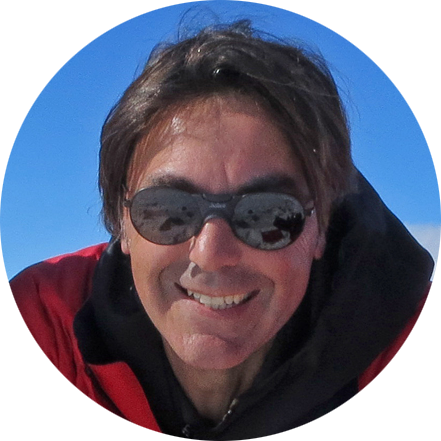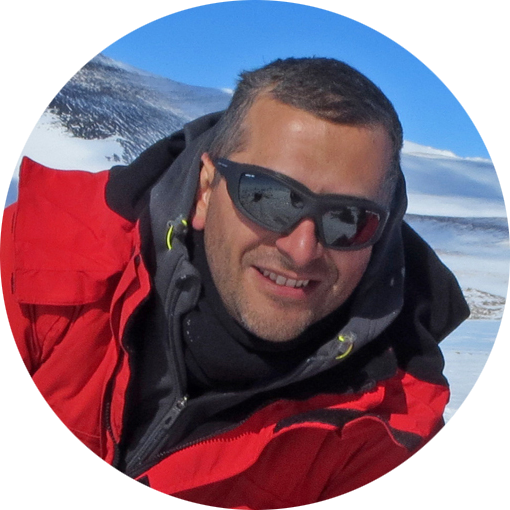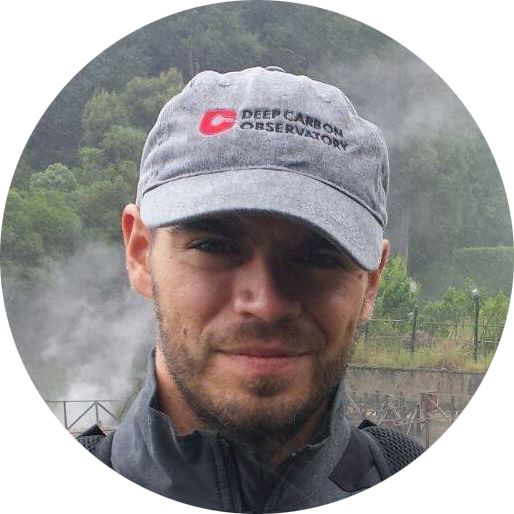In a snapshot - During the XXXIII PNRA Antarctic expedition (December 2017- February 2018) we (Maurizio, Matteo, Jèrôme, the scout Francesco and I) recovered 115 meteorites for a total mass of 5 kg. Most meteorites were found at the Reckling Moraine ice field, Victoria Land, Antarctica. The collection includes a sample from the Moon (~11 g), one from the surface of asteroid 4Vesta (~94 g) and several unequilibrated primitive chondrites.
The (long and beautiful) journey south - After a 36 hour airline flight from Europe, we left Hobart (Tasmania) on December 13th aboard Research Survey Vessel Aurora Australis. After a few hours of navigation we hit a couple of major storms. We.pitched and rolled heavily for five days in waves 15 m high until we crossed 60˚ S. Then calm, fleets of icebergs, albatrosses gliding for "... ever" around the ship, penguins and seals sunbathing on rafts of fast ice, and again puffs of killer whales. Stunning.

Counts of icebergs
After 9 days of navigation we set foot on land. We stopped over Casey Station (Australia) for two days, enjoying the Ozzy cheer (and the locally brewed beer). We then left for Mario Zucchelli station (MZS), our final destination, on a small Bassler propeller on December 23rd. We stopped at Concordia station (France-Italy) on top of the plateau, half-way across East Antarctica to refuel. Airborn, the captain Jim informed us that the weather was very bad at our destination. We were then redirected to Dumont D'Urville station (France) along the Antarctic coast in Adelie land. Good French stew for supper! The day after we flew to MZS where where we joined the other expeditioneers for the Christmass evening buffet!
At Mario Zucchelli Station. Our prolonged 4 week stay at MZS before leaving for the field was mainly due to bad weather and general logistic issues. In particular, we were unable to reach our planned field work area at Finger Ridges ice field, 500 km due south of MZS with the propeller Twin Otter, because we were unable to find a good landing spot. We then managed to complete seven day trips to collect micrometeorites from the tops of the Outback Nunataks, Transantarctic Mountains and to search for an alternative area in which to camp and search. As a result we collected several thousand micrometeorites (and microtektites), and found a place where to pitch our camp: Reckling Moraine icefield, ~240 km due SSW of MZS in the catchment of the David and MacKay Glaciers. Although the area had already been searched in the '80s by the US ANSMET team, we found 27 meteorites during a 12 hour search. Not bad! An earlier day visit to a small ice patch in the MacKay Glacier catchment produced the first three meteorites of the 2017-18 PNRA collection during a 6 hour search. Nevertheless we though Reckling Moraine would have been the right spot to set the camp this season.
Remote camp at Reckling Moraine. On January 19th, more than a month after we left home, we flew from MZS by helos to Reckling Moraine icefield. Although the katabatic wind was strong that day (25-30 knots), we managed to pitch the camp at lat -76.22, long 158.62, elevation 2100 m. Two Jamesway huts, one living, one dormitory, one "toilet" tent, and HF antennas for radio communication in 14 hour non-stop work. A good hot soup for dinner and crashed in "bed". The morning after, still strong wind, clear sky and a stunning view of the of a huge, 100 m high ice ramp that, like a gigantic wave, propagates E-W across the entire extension of the 30 km long blue ice field.

Reckling Moraine remote camp for the search form meteorites
During the 17 days spent at the camp, we managed to search for 12 days by skidoo and on foot covering about 50% in the ice field which totals 200 km2. An additional 85 meteorites were found, bringing the total to 115. Great excitement when first Matteo and then Maurizio spotted pieces of asteroid 4Vesta and the Moon sitting on the ice. For three days we had to stay put in the tents due to strong storms, with 30 knot winds or total white out. Lots of book reading, paper writing, movie watching and cooking.

The ~11 g lunar meteorite recovered during the XXXIII PNRA Antarctic Campaign
Packing up. On February 4th we struck camp. As predicted by Murphy's law was one of the windiest day we ever had. Back to MZS in the evening. Hot shower and lots of stories to tell. We spent two days conditioning our samples; meteorites were dried in a vacuum chamber, re-bagged, labeled and packed to be delivered to the Museo Nazionale dell'Antartide in Siena, Italy where they are curated a distributed to scientific community. We left MZS for McMurdo station (USA) by Twin Otter on February 6th. Staied in McMurdo over night to then leave for Christchurch (New Zealand) aboard US Air Force C17 aircraft. Definitely a comfy flight of only 5 hours, but nothing compared to the intense journey south.
Meteorite location map
Team:
Luigi Folco
 Dipartimento di Scienze della Terra, Università di Pisa, Italia
Dipartimento di Scienze della Terra, Università di Pisa, Italia
Principal Investigator
Field Leader
Research Interests
- Cosmochemical study of meteorites and micrometeorites
- Geochemical study of impactites
- Search for meteorites in hot and cold deserts
Questo indirizzo email è protetto dagli spambots. È necessario abilitare JavaScript per vederlo.























